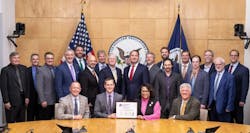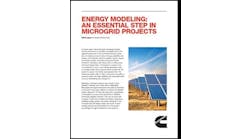Next-Gen Nuclear Milestone: NRC Approves Construction Permit for Natura Test Reactor
The movement to build small and advanced nuclear reactor energy generated some serious momentum this week.
The U.S. Nuclear Regulatory Commission has issued a construction permit for a molten salt reactor pilot project at Abilene Christian University in Texas. Developer Natura Resources would deploy its MSR-1 system at ACU and operate the 1-MW in tandem with the school’s Nuclear Energy eXperimental Testing (NEXT) Laboratory.
The MSR-1 would not be commercially operational and would only be maintained at low power for research purposes. This marks the first NRC construction permit for a liquid-fueled advance reactor and only the second for any advanced reactor project.
American research to solve an American energy challenge
Nuclear fission power is carbon-free and operates with a high-capacity factor. Many proponents see small modular reactors (SMR) and next-gen nuclear technologies as ideal for meeting the rising demand of data centers, industrial electrification and sustainability goals.
“Natura recognized early on that the NRC is the gold standard of licensing of nuclear reactors,” Douglass Robison, founder and president of Natura Resources, said in a statement. “We made a conscious decision to work with the NRC to license our technology for deployment here in the (United States) rather than taking our technology outside their jurisdiction or attempting to avoid the licensing process entirely.“
Natura Resources has worked with Abilene Christian since 2020 and brought the school’s NEXXT Lab together with a joint effort from Texas A&M, University of Texas and Georgia Institute of Technology to form the Natura Resources Research Alliance.
The research gleaned from the campus research project should inform Natura’s work on its planned 100-MW systems. The pilot project will utilize graphite-moderated, fluoride salt flowing fluid to cool the reactor, which some theorize is safer than water-cooled technologies. If a system fails, under this theory, the salt solidifies around the reactive uranium and could prevent overheating, according to reports.
Check out our new and free E-Book on SMRs and Microgrids
Prospects for a Small, Modular and Reactive Future
The advanced reactor deployment site built to house the Natura MSR-1 project, the Science and Engineering Research Center at ACU, was completed last year. The NRC approval allows the research team to begin fabrication of the reactor.
Zachry Nuclear Engineering will work on the engineering and design phase of the MSR-1 with hopes of completing that early in 2025. The U.S. Department of Energy will provide fuel and salt for the reactor project.
ACU’s research is working to advance technical readiness levels of critical equipment needed in molten salt reactor operation, including flow meters, flanges, seals, level sensors, salt monitors, instrumentation and other hardware.
“Another huge milestone for Natura Resources, ACU and all of our partners,” Rusty Towell, university professor and director of the NEXT Lab, said on his LinkedIn post announcing the NRC construction permit. “Massive team effort, and I’m thankful to be a part of this project that will bless the world.”
Indeed, many in the energy, commercial and industrial sectors envision next-gen and small nuclear as key directions forward to building a power generation system that can help meet net zero goals. Currently, the conventional nuclear energy fleet in the U.S. contains more than 90 generation units accounting for nearly 20% of the nation’s electricity resource mix.
That percentage of nuclear power in the electricity mix has dropped in recent years because only a few new reactor plants have been built in the U.S. over the past three decades. Meanwhile, the utility grid may be entering a power adequacy crisis because GWs of coal-fired capacity were retired and neither solar nor wind energy can provide the constancy required by industrial customer demand.
Nuclear energy also contributes more than half of the utility-scale carbon-free power generated in the U.S., according to federal statistics. Recently, Oracle founder Larry Ellison said his software and data company was planning to eventually utilize SMR reactors to power a new data center facility.
Data center industry believes in SMR nuclear
During the Data Center Frontier Trends Summit two weeks ago in Reston, Virginia, industry leaders talked about the compelling case for SMR nuclear to power an exponentially growing array of data centers necessitated by artificial intelligence and cloud-based capacity.
“Nuclear is way more versatile” and reliable than other carbon-free fuels, James Walker, CEO of Nano Nuclear Energy, said during a panel on the Data Center Nuclear Frontier. “China came to this conclusion years ago, and they are building nuclear like crazy. They need that consistent power.”
Nissan fission, of course, has its detractors who point to formidable financial, siting and safety challenges. The Vogle 3 and 4 expansion projects in Georgia, completed in recent years, cost close to $33 billion, but now generate more carbon-free electricity than any other resource in the U.S.
For many skeptics, nuclear energy also conjures fearful images of radioactivity and meltdowns such as Chernobyl, Fukushima and Three Mile Island, although the latter inflicted no lasting health issues or deaths for humans.
Non-weaponized nuclear energy in the U.S. has powered Navy submarines for decades. Reactors also have generated close to a fifth of total utility-scale electricity, with far fewer of the respiratory or other health issues derived from clouds of coal-fired emissions.
On the waste issue, as the U.S. Department of Energy has pointed out, decades of nuclear fission haven’t yielded more than a football field’s worth of waste nationwide.









